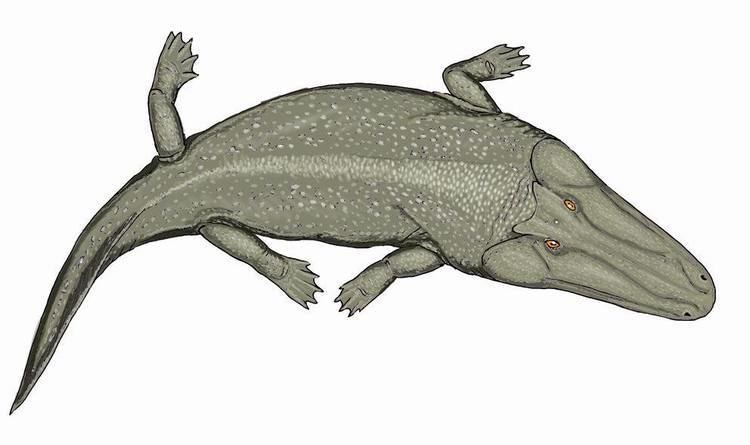 | ||
In the geologic timescale, the Anisian is the lower stage or earliest age of the Middle Triassic series or epoch and lasted from 247.2 million years ago until 242 million years ago. The Anisian age succeeds the Olenekian age (part of the Lower Triassic epoch) and precedes the Ladinian age.
Contents
Stratigraphic definitions
The stage and its name were established by Austrian geologists Wilhelm Heinrich Waagen and Carl Diener in 1895. The name comes from Anisus, the Latin name of the river Enns. The original type locality is at Großreifling in the Austrian state of Styria.
The base of the Anisian stage (also the base of the Middle Triassic series) is sometimes laid at the first appearance of conodont species Chiosella timorensis in the stratigraphic record. Other stratigraphers prefer to use the base of magnetic chronozone MT1n. The global reference profile for the base (the GSSP or golden spike) is at a flank of the mountain Deşli Caira in the Romanian Dobruja.
The top of the Anisian (the base of the Ladinian) is at the first appearance of ammonite species Eoprotrachyceras curionii and the ammonite family Trachyceratidae. The conodont species Neogondolella praehungarica appears at the same level.
Especially in Central Europe the Anisian stage is sometimes subdivided into four substages: Aegean, Bythinian, Pelsonian and Illyrian.
The Anisian contains six ammonite biozones:
Palaeontology
Examples of vertebrates from this age are:
†Ceratitida
Ananorites Arthaberites Beyrichites Bosnites Buddhaites Bukowskiites Caucasites Danubites Gangadharites Japonites Laboceras Longobarditoides Mesocladiscites Noetlingites Parapinacoceras Parasageceras Phyllocladiscites Proavites Pseudodanubites Psilocladiscites Salterites Tropigymnites Xiphogymnites Pararcestes Sageceras
Lower
Alloptychites Anagymnites Grambergia Groenlandites Gymnites Lenotropites Pearylandites Silberlingites Isculites Stenopopanoceras
Middle
Acrochordiceras Alanites Anagymnotoceras Arctohungarites Balatonites Bulogites Cuccoceras Czekanowskites Epacrochordiceras Hollandites Huishuites Inaigymnites Ismidites Kiparisovia Malletophychites Nicomedites Phillipites Platycuccoceras Pronoetlingites Reiflingites Discoptychites Intornites Nevadisculites Paraceratites Parapopanoceras Proarcestes Longobardites Ptychites
Upper
Amphipopanoceras Aplococeras Arctogymnites Eudiscoceras Eutomoceras Gymnotoceras Halilucites Judicarites Kellnerites Metadinarites Nevadites Parakellnerites Proteusites Repossia Semiornites Serpianites Stoppaniceras Ticinites Tozerites Tropigastrites Joannites Epigymnites Ceratites Flexoptychites Frechites Norites Gevanites Hungarites
†Phylloceratida
Spinoleiophyllites Ussurites Monophyllites
Nautilida
Trachynautilus Thuringionautilus Styrionautilus
Lower
Indonautilus Sibyllonautilus
Middle
Paranautilus
Upper
Holconautilus Proclydonautilus
†Aulacocerida
Crassiatractites Breviatractites
Lower
Mojsisovicsteuthis
Pterioida
Ramonalinidae
